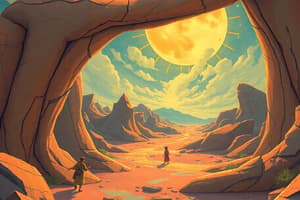Podcast
Questions and Answers
Which artistic element is MOST directly associated with conveying a sense of motion, energy, and guiding the viewer's eye through a composition?
Which artistic element is MOST directly associated with conveying a sense of motion, energy, and guiding the viewer's eye through a composition?
- Color Intensity
- Value
- Texture
- Line (correct)
If an artist uses only variations of the same hue in an artwork, what type of color harmony is being employed?
If an artist uses only variations of the same hue in an artwork, what type of color harmony is being employed?
- Analogous
- Monochromatic (correct)
- Complementary
- Triadic
The use of light and shadow to create a three-dimensional appearance when depicting objects is MOST closely related to which element of art?
The use of light and shadow to create a three-dimensional appearance when depicting objects is MOST closely related to which element of art?
- Texture
- Repetition
- Line
- Shape and Mass (correct)
When viewing a piece of art, which of the following concepts is most aligned with the idea of critical thinking and drawing comparisons between different images and objects?
When viewing a piece of art, which of the following concepts is most aligned with the idea of critical thinking and drawing comparisons between different images and objects?
Which principle of art is achieved when all parts of a composition contribute to a sense of completeness and wholeness?
Which principle of art is achieved when all parts of a composition contribute to a sense of completeness and wholeness?
The principle of art that relies on the use of contrasting elements, like light and dark values, or juxtaposing different subjects, to create visual interest is best described as:
The principle of art that relies on the use of contrasting elements, like light and dark values, or juxtaposing different subjects, to create visual interest is best described as:
An artwork using elements that are noticeably lighter or darker to draw the viewer's attention to a specific region or idea would MOST effectively be employing which principle of art?
An artwork using elements that are noticeably lighter or darker to draw the viewer's attention to a specific region or idea would MOST effectively be employing which principle of art?
In the context of art, what is the primary function of 'shared cultural knowledge' in the interpretation of a visual piece?
In the context of art, what is the primary function of 'shared cultural knowledge' in the interpretation of a visual piece?
Flashcards
Visual Culture
Visual Culture
The study of how people create, interpret, and interact with visual information.
Visual Literacy
Visual Literacy
The ability to critically analyze and understand visual materials, recognizing comparisons and contrasts between different types of images and objects.
Cognition
Cognition
The combination of mental processes, allowing us to understand and interpret visual information.
Shared Culture Knowledge
Shared Culture Knowledge
Signup and view all the flashcards
Line (Visual Art Element)
Line (Visual Art Element)
Signup and view all the flashcards
Color and Value (Visual Art Element)
Color and Value (Visual Art Element)
Signup and view all the flashcards
Shape and Mass (Visual Art Element)
Shape and Mass (Visual Art Element)
Signup and view all the flashcards
Texture (Visual Art Element)
Texture (Visual Art Element)
Signup and view all the flashcards
Study Notes
Visual Culture and Literacy
- Visual culture involves viewing events for information, meaning, or enjoyment.
- Visual literacy is critical viewing, comparing, and contrasting visuals.
- Embodied viewing and cognition (mental operations) are integral aspects of studying visuals.
- Shared cultural knowledge influences the interpretation of visuals.
Art Elements
- Line: Defines shape, form, and conveys movement, energy, and direction. It creates rhythm, patterns, and texture; expressing emotions like energy or crudity.
- Color and Value: Color arises from light and includes hue (name on the color wheel), intensity (purity), and value (light/dark). Color harmonies include monochromatic, complementary, analogous, and triadic. Color affects emotions.
- Shape and Mass: Shapes define space (2D or 3D). Mass can be defined with light and shadow. Shapes define space that can be contained or broken to suggest movement.
- Texture: Can be actual (physical) or implied (visual).
- Space: 2D, 3D, or using perspective—implied or linear (with vanishing points, horizon line, receding lines).
Art Principles
- Contrast: Emphasizes differences (dark/light, old/young, etc.)
- Repetition and Pattern: Repeating elements creates visual patterns.
- Emphasis: Highlights a specific area (scale).
- Balance: Includes symmetry.
- Movement/Rhythm: Creates visual flow or sense of timing.
- Unity: Elements combined to create a sense of wholeness.
Art Terminology
- Medium/Media: Materials used to create an artwork.
- Subject Matter: The visible thing/focus in the work.
- Content/Meanings: Underlying ideas and messages.
- Narrative: Story or message conveyed.
- Style: Period or artist's unique approach.
- Genre: Type of artwork (e.g., portrait, landscape).
- Iconography: Visual symbols and their meaning.
- Iconoclasm: Destruction of images.
Studying That Suits You
Use AI to generate personalized quizzes and flashcards to suit your learning preferences.




